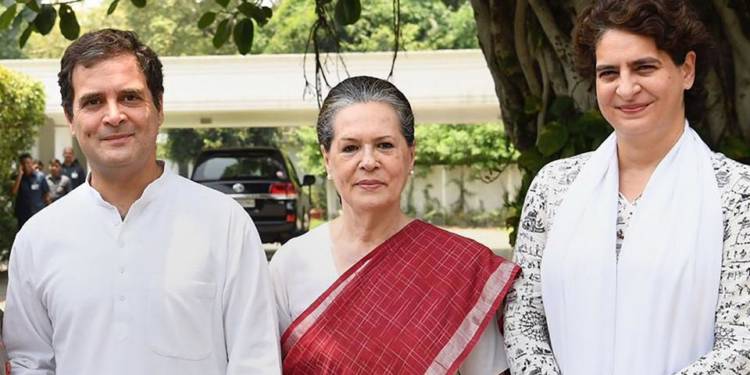As the final numbers for the Maharashtra state assembly elections settle in, BJP led NDA is poised to rule for another term in both Haryana and Maharashtra. These elections also witnessed slight repositioning of the opposition especially in the case for NCP in Maharashtra and Congress in Haryana. The Congress, despite being the biggest loser of these state elections, has also certainly emerged to benefit the most out of its newfound strategy of keeping the Gandhis away from election campaigns.
The assembly polls in Maharashtra and Haryana saw an interesting pattern. In these two states Congress performed above expectations of political analysts who had virtually written off the grand old party however, it was certainly not due to the efforts of the Gandhi family.
These two states saw little effort from the Gandhi family as Rahul Gandhi attended only 4 rallies in Maharashtra and just 2 in Haryana, whereas Sonia Gandhi and Priyanka Vadra skipped both.
While in Maharashtra, the Congress finds itself only marginally better as it managed to improve its tally from 42 to 44 in the Maharashtra legislature. However, it is the state of Haryana where the party witnessed resurgence which defied expectations. From being reduced to 15 seats in 2014, the party’s tally rose to 31 in the just concluded election which baffled many political analysts.
With these results insight the speculations over growing irrelevance of the Gandhi family are sure to arise as contrary to other elections where Gandhi family was involved heavily, the Congress had to suffer embarrassing defeats, on the other hand, these elections which saw passive involvement of Gandhi family turned out to be advantageous. Nonetheless, these assumptions surely will need further support.
The move to appoint Rahul Gandhi as the Congress Vice President in January 2013, was hailed by a large section of the media as the mark of a new beginning for the young (then 43-year-old) leader. However, with clever politics at play, many observers had noted the underlying idea behind this dramatic assent, the upcoming Lok Sabha elections just months away in the summers of 2014.
What followed was a soft projection of Rahul Gandhi as the Prime Minister candidate by the Congress, also joining the efforts to project Rahul Gandhi was that a section of media, nurtured over decades under the rule of Congress.
However despite overarching efforts, in the 2014 General election, the grand old party faced a humiliating defeat by posting its worst-ever performance in its electoral history. A party which had once ruled with more than 400 seats in the Lower House was just reduced to 44 seats. The electoral defeat in the 2014 general election was however just a beginning of a series of defeats Congress was yet to face in various state elections. The 2014 state assembly election in Maharashtra, Haryana and Jharkhand , 2015 state assembly elections in Bihar and Delhi, 2016 state assembly elections in Assam, Kerala, Tamil Nadu and West Bengal , 2017 state assembly elections in Goa, Gujarat, Himachal Pradesh, Manipur, Uttar Pradesh and Uttarakhand and 2018 state assembly elections in Meghalaya, Mizoram, Nagaland, Telangana and Tripura, Congress lost on all fronts mainly to its principle opposition the BJP and other regional forces like AIADMK in Tamil Nadu and CPIM in Kerala.
It is to note that the grand old party had relied heavily on the Gandhi family, without nurturing any strong regional face. While Congress was successful in registering victories in certain state assembly like in 2017 Punjab assembly elections and other marginal victories like in the 2018 Madhya Pradesh Assembly elections and others, all the states where reasonably strong regional leaders like Captain Amarinder Singh, Ashok Gehlot, Sachin Pilot, Jyotiraditya Scindia, Kamalnath and others were present.
However, not much later in the 2019 General Election Rahul Gandhi’s fate was sealed with Congress repeating its humiliating electoral performance to arrive at dismal 52 seats in 2019. The grand old party added to its tally, however, the margin of victory was considerably reduced compared to the last general elections. Tall leaders like Mallikarjuna Kharge, Jyotiraditya Scindia even Rahul Gandhi lost from erstwhile strongholds of the Congress.
The Congress has also suffered in Uttar Pradesh during the Lok Sabha elections where the Gandhis had campaigned extensively. Among the UP seats where Priyanka Gandhi Vadra campaigned and the Congress lost include, Daurarha, Barabanki, Unnao, Kanpur, Jhansi, Pratapgarh, Jaunpur, Kushi Nagar, Sultanpur, Bhadohi, Dumariaganj, Basti, Fatehpur and Sant Kabir Nagar.
Apart from the failure in UP, Priyanka’s campaigning had also failed in the other northern states of Punjab, Assam, Haryana, Delhi, Madhya Pradesh, and Himachal Pradesh. In the total 12 seats in which she campaigned outside UP, Congress lost in 11, including, Silchar, Ambala, Hisar, Rohtak, North East Delhi, South Delhi, Ratlam, Indore, and Mandi. In the total number of 31 seats Priyanka Vadra campaigned, the party has lost 30 of them, bringing her success rate to 3%.
These state elections where regional leaders like Bhupinder Singh Hooda had taken active charge coupled with the Gandhis keeping their hands out, the grand old party has performed better indicating a subtle shift of the intraparty power centre.
Historically, too the congress has relied heavily on strong regional readers to keep up their political game. It was in Nehru’s era which saw regional leaders being given ample freedom who went on to emerge as big leaders themselves. Following Nehru, it was Indira Gandhi who had started the centralization of power and kept consolidating more and more support throughout her political career. Rajiv Gandhi was expected to revive the old decentralised model for the Congress, however, he too decided to keep the power consolidated in the hands of the Gandhi family.
Furthermore, with the rise of Sonia and Rahul Gandhi, the party had adopted an even more intense centralised method of functioning with the power residing solely in the hands of the Gandhi family. Nonetheless, with these current developments, a strategy by the congress to decentralise the election campaigns by keeping the Gandhis at bay might be expected.
However, for the Congress, the electoral crisis goes deeper than the question of Gandhi family. Over decades organizational structure of Congress has been systematically transformed from a cadre-based party to family-run show. All the important positions of the Congress’ organizational structure are predominantly decided by a group of select individuals which form the so-called Congress Working Committee. Full of Gandhi-Nehru-Vadra family loyalists, CWC of the Congress has been notorious for taking unilateral decisions based on the whims and wishes of Gandhi-Nehru family, however taking into consideration all the current electoral developments as in Haryana, the decentralisation of power in the Congress is not only indispensable but also imminent.


































